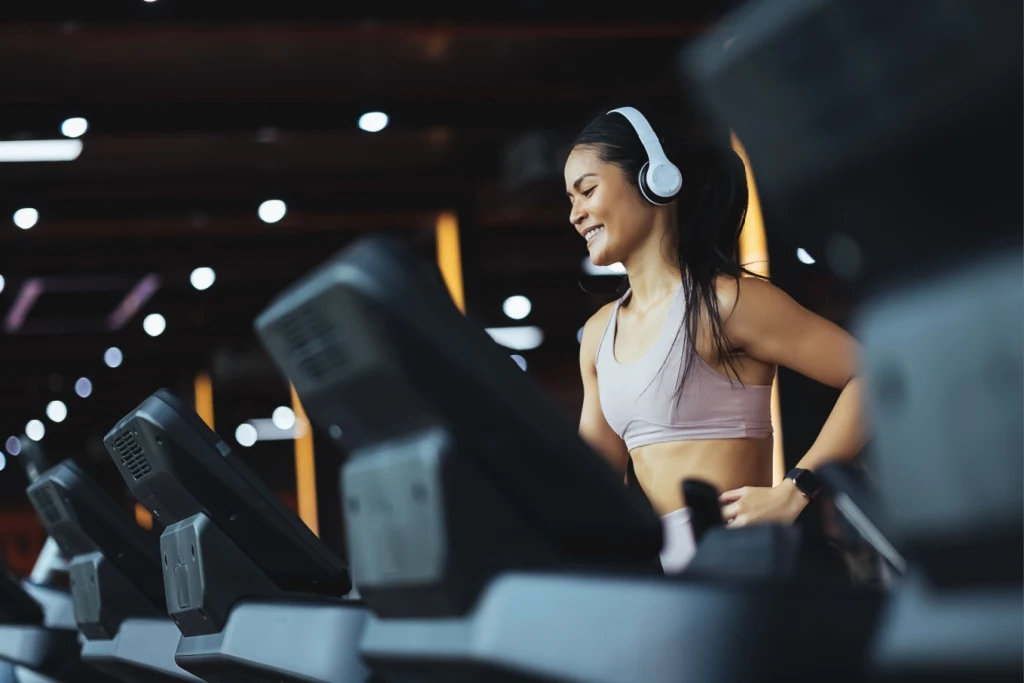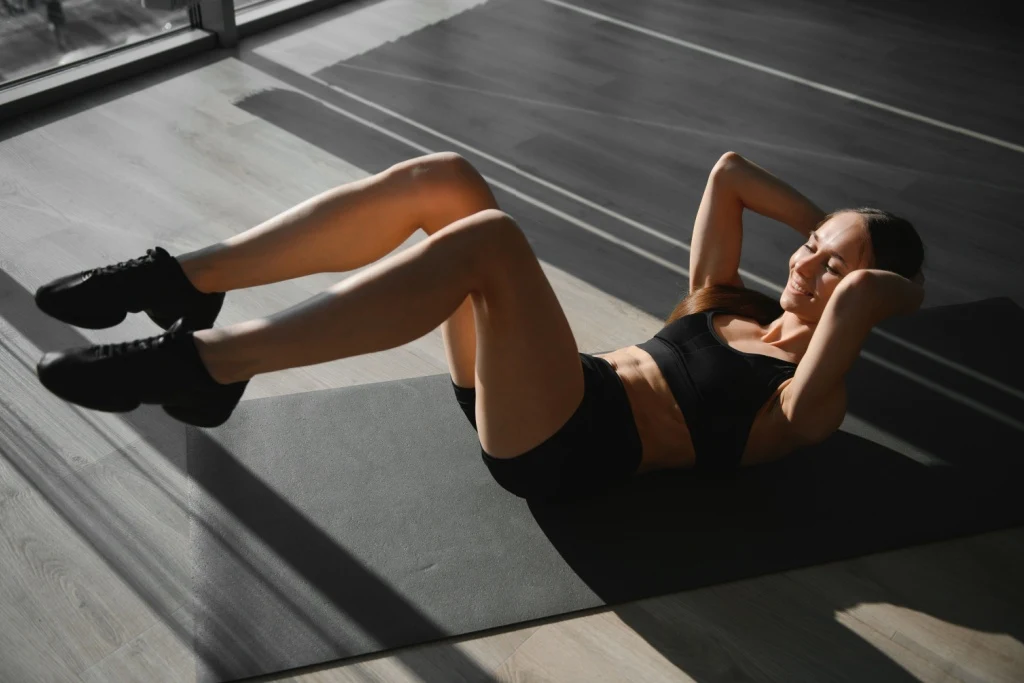Fitness Myths Busted: Sorting Fact From Fiction
For your best feel-good fitness journey, here are some of the fitness myths you should ditch, stat.

December 13, 2019 - Updated October 24, 2024

In the world of all things fitness, there’s a lot of rock-solid advice out there that’s backed by science, but there’s also a lot of noise, fluff and straight-up BS.
Here at Sweat, we’re always going to promote fitness advice that’s grounded in science and the nuggets of wisdom that are going to set you up for lifelong, feel-good, healthy habits. However, it’s worth being wary of some of the most common fitness myths you should steer clear of on your journey. Here are six of the fitness myths we hear most often - and why they’re more fiction than fact.
1. It wasn’t a good workout unless your muscles hurt the next day
There’s a common misconception that when your muscles hurt in the days following a workout (aka DOMS or delayed onset muscle soreness), it’s an indication that you’ve challenged yourself enough to cause micro-tears to the muscle fibres, therefore eliciting muscle growth and the results you want. Although this might be true, it doesn’t mean that without muscle aches, you’re not making progress.
As your workout routine becomes more consistent and your body adjusts, it’s natural and normal for you to experience fewer aches, even if you can see you’re clearly making progress. PSA: you can definitely have an amazing, effective workout and not experience DOMS the next day.
DOMS also aren’t something you want to aim for in every single session, as they can interfere with your workout routine or lead to overtraining and increased risk of injury if you continue to exercise.
2. You need to do cardio to lose weight
Again - nope! If losing weight is one of your health and fitness goals, the main thing you need to achieve is a calorie deficit, meaning that at the end of each week, you’ve burned more energy than you’ve consumed.
Although cardio sessions (such as walking, jogging, swimming or cycling) obviously burn calories and can contribute to weight loss, they’re not essential or the only way to achieve this goal.
You could lose weight by focusing on nutrition alone to achieve a calorie deficit, or a combination of nutrition and strength training. We love cardio and recommend including it in your routine for the huge number of health benefits it offers, but if we’re talking about cardio in the context of weight loss, it’s not a must-have. As the saying goes, there are many ways to skin a cat.

3. Lifting weights will make you bulky
Luckily, the number of people who believe this has taken a sharp nosedive in recent years thanks to the popularity of strength training, but it’s still worth clearing this up anyway.
Sweat trainer Katie Martin was someone who fell for this myth back in the day, and she wishes she could go back in time and tell her younger self what she knows now.
“I avoided weights because I thought they made me bulky. I made cardio the foundation of my training. I definitely didn’t eat enough protein (hello, smoothie bowl era!),” Katie shared with her community. “Little did I know it was STOPPING me from achieving my goals.”
Gaining muscle is a very gradual process that requires a consistent and challenging strength training routine, alongside adequate protein intake to fuel your body and support your goals.
Besides that, lifting weights offers so many benefits and it should be part of everyone’s fitness routine. Increasing your muscle mass means improving your body composition, and having a stronger body is great for your posture, bone density, sleep quality, balance, mood, and reducing your risk of injury - just to name a few.
If anything, you can expect to fall in love with how you look and feel when strength training is a regular part of your life.
4. You can spot reduce with the right exercises
Spot reduction is a term or a theory that refers to the idea that you can lose fat from certain areas of the body, especially if you’re doing exercises to target that area. It can be quite a believable theory, but it’s not true. We’ve all seen those workouts full of crunches that promise you’ll lose belly fat, and that’s just not how fat loss works.
When you follow a nutrition or training plan designed to help you achieve fat loss goals, you can’t choose where your body will lose fat from - your entire body will gradually lose fat in the process. You may find certain parts of your body shed weight faster than others, but that has less to do with the exercises you’re doing and more about genetics, hormones, gender and life stage.

5. Being exhausted is a sign of a good workout
Many of us have had the experience of finishing a workout and being an absolute mess. You’re dripping in sweat, your muscles are shaking, your face has turned a gorgeous shade of tomato, and you need a few minutes before you can even think about getting up off the floor.
For some people, intense workouts like this make them feel incredible. For others, it’s their worst nightmare. Regardless of what camp you sit in, it’s important to know that finishing your last rep with nothing left in the tank is not a box you need to tick each time you exercise.
A successful workout can be one that improves your mood, challenges your muscles, gets your heart rate up or simply gets your body moving, and you can make phenomenal progress without burning yourself out.
6. The longer a workout, the more effective it is
Life is busy and thankfully, you don’t need to have hours of free time up your sleeve to achieve your fitness goals. Whether you’re a fan of Pilates, weight lifting, HIIT or barre, you can still have a great workout in under 30 minutes with the Sweat app. When it comes to seeing results and making progress on your journey, consistency trumps intensity and fitting in multiple short workouts each week is always going to be better than completing one long session.
Even if you do have all the time in the world, there are smarter ways to train. Sweat trainer Sarah Smith is a big believer in this, saying that since becoming a mother of two, her workouts have become shorter than ever but she feels fitter and stronger than ever. It’s not how long your workout is that matters most, it’s what you do with it.
Effective training starts here
Regardless of how you like to train, where you want to work out or how much time you have to dedicate to your fitness routine, Sweat’s extensive range of programs have all been designed by professional trainers with years of experience and your unique goals in mind - minus the BS. So, are you ready to Sweat?

Erin is a writer and editor at Sweat with years of experience in women's publishing, the fitness industry, media and tech. She's passionate about the power of movement, and you can often find her on a yoga mat, a hike, a dance floor, in the ocean or the gym.
* Disclaimer: This blog post is not intended to replace the advice of a medical professional. The above information should not be used to diagnose, treat, or prevent any disease or medical condition. Please consult your doctor before making any changes to your diet, sleep methods, daily activity, or fitness routine. Sweat assumes no responsibility for any personal injury or damage sustained by any recommendations, opinions, or advice given in this article.
Fitness